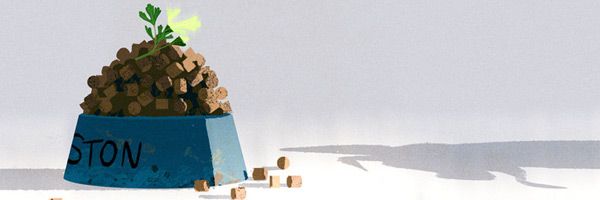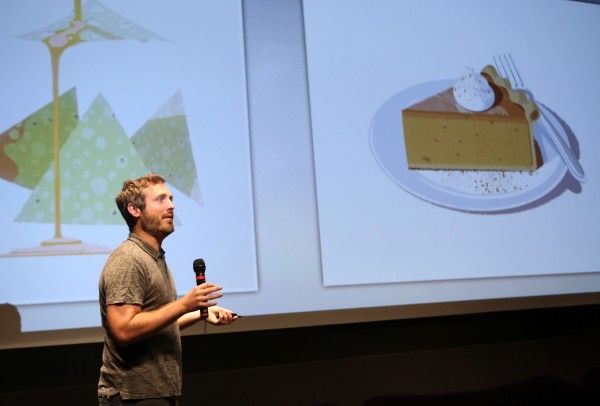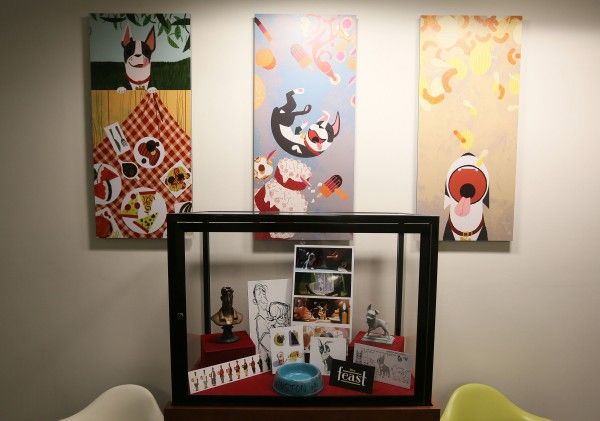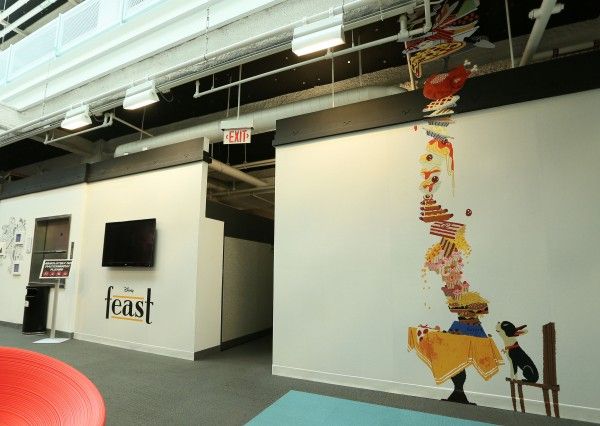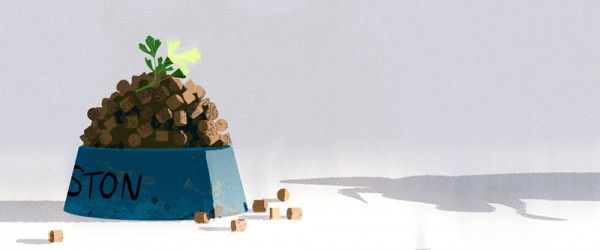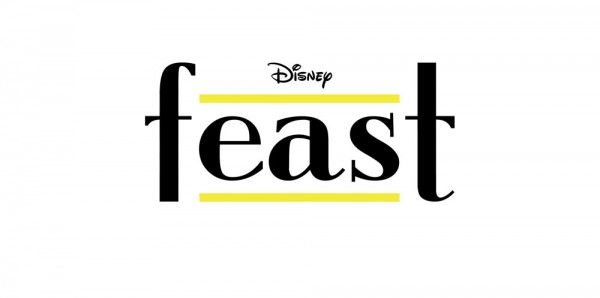The upcoming animated short film Feast, which will run in theaters with Big Hero 6, opening on November 7th, is the story of one man’s life, as seen through the eyes of his best friend and dog, Winston, and revealed through the meals that they share. It’s a beautiful, funny, heart-warming story about love.
During a recent presentation and screening at Walt Disney Animation Studios, to showcase their latest short, director Patrick Osborne talked about how quickly Feast went from pitch to finished product, all with the guidance and support of John Lasseter. During the interview, he discussed where this idea came from, making this as part of Disney’s shorts program, what the pitch process is like, creating the look of the food, developing a short versus a feature, what the lighting process is like, the must-have foods that he wanted to include, why he chose to make the human characters out of focus, the biggest challenges in coming up with the story, the most technically difficult scene, and collaborating with John Lasseter throughout the process. Check out what he had to say after the jump.
Question: Where did this idea come from?
PATRICK OSBORNE: I’ve been working on this for the last year, and it’s so hard to keep it a secret that I’m glad to finally be able to talk about it and show [it to audiences]. I’ve been using this app called “One Second of Your Day,” where you record your life in one-second clips, and I’ve been doing it for about two years. I did one of my life, and I did one of meals. There was something interesting about the dinner one, and I though tit might be cool to see if I could use it in animation to tell a story through food and through dinners.
How did you come to be making this through the shorts program?
OSBORNE: This is the first actual short done at Disney through our new shorts program. Over the last couple of years, we’ve had a couple of shorts go in front of movies, and it became clear that that was something that the studio wanted to keep doing. They decided that they wanted to formalize it, in some way, so about a year and a half ago, they announced that they were going to open up pitches to the whole studio. One of [John] Lasseter’s things is that you need three ideas. You have to pitch three ideas, to not put all of your eggs in one basket and to show the breadth of who you are, as an artist. I’ve been working here for about seven years, as an animator. At the time, I was in my dream job. I was the co-head of animation on Big Hero 6, our next movie, with Zach Parrish. We were working for about nine months, getting the characters ready to send off to the animators to make the movie. But there was something about this that made me want to jump at that and see what it’s like to pitch to the shorts trust and Lasseter, so I threw my ideas in. There’s something really cool about the amount of life that you see, just in showing meal after meal, for cut after cut. It just felt like it was something to center a short around. So, I started with that concept and mixed it with the patterning and color of different types of food and plates on the table. The only thing missing was a throughline. We thought that maybe we could get a dog under the table and show his life with this family, and let the human life be in the background.
What is that pitch process like?
OSBORNE: You end up with your three ideas on boards, and you get into a very intimidating room with six directors and John Lasseter, and you pitch your shorts. And then, you wait. I waited and continued working on Big Hero 6 for a couple months. And then, one day, they said that they were going to make my short. Instantly, everything changed. I was no longer working on Big Hero, and I had a deadline of story, which I’d never done. You start to work on story and figure out how the actual short is going to play out, but at the same time, you figure out what it’s going to look like. A couple of years ago, I was the head of animation on Paperman. At the time, we were playing around with ways to make the animation look different from our features. We wanted to still use our modern tools and tool set, but make things that were exciting to us and felt fresh, and Paperman was one step in that direction. We decided to use similar tools, but do it in a little bit of a more naturalistic style of shooting.
Once you got the go-ahead on the short, where did you start?
OSBORNE: The first thing I did was to bring on Jeff Turley as production designer. We wanted it to be colorful and full of energy, so Jeff went out to explore and do things that were exciting to him. If you’re going to do something different, you have to be direct with the rest of the team, as to what that means. There was not a lot of textural realism and detail, but there was natural light and a natural feel to the way it looked, even though it was simple. And the color choices were all based on nature. You have to have that kind of a guide for the rest of the team to know exactly where you’re going. When you start designing the characters, it’s nice to put them in little moments because you can start to understand them, visually. You can really see the life emerging and the relationships forming.
How did you approach creating the look of the food?
OSBORNE: Because the short was going to be shot in very quick cuts, we had to make sure that the foods themselves were identifiable and iconic and delicious at first look. So, Jeff went through and made these pieces of modern art that just looked incredible. The idea was that you can identify the food really quickly, just on first glance.
What is the difference between developing a story for a short versus doing so for a feature?
OSBORNE: With features, story gets approved in small amounts. The nice thing about a short is that it all goes at once. It’s a blessing and a curse because you know exactly what you’re making, but you instantly have layout that needs to be done. As soon as you walk out of that meeting where Lasseter is like, “It’s beautiful guys, let’s go,” you walk into another meeting where everyone tells you the deadlines. Since I had never actually done any of this before, all the way through, everything was a learning process. We had a small panic moment where we were promising all of this amazing graphic storytelling and cinematography and light, and we were starting the layout and hadn’t planned it. So, we had this emergency two-hour lunch/drawing session with Jeff Turley, the production designer, and Josh Staub, the effects supervisor, to figure out what every shot was actually going to be. We went through every shot and drew it in a simple black/grey/white value structure that guided the emotional arc of the story.
What’s the lighting process like?
OSBORNE: The lighting team goes through it, but doesn’t light it traditionally. It’s more of a Photoshop trick. You take all of the colors and adjust them, and you hand paint in the shapes. You use a lot of help from the CG side to get the lighting shapes exactly right. But it’s a very designed and non-realistic process. That gets you to a result that I think is beautiful and works. I’m very happy with it.
What were the must-have foods that had to be included?
OSBORNE: The burger and fries had to happen. There are certain story foods that mean more. From the beginning, the football table flip had to be there. And we wanted some kind of brussel sprout childhood gross food. I love brussel sprouts now. I think my mom just made them wrong. And the fast food thing, at the beginning, had to happen. That crinkle fry was the most iconic thing that we could start out with, so that people could get it without taking too much time.
Did you intentionally decide not to have the people in focus until closer to the end of the short?
OSBORNE: Coming from animation, I hadn’t thought about this too much, but point of view is a big deal in storytelling, in general. It felt like, once I really got into the head of what the dog was caring about, that if we somehow had a way, with cinematography, to tell the audience what the dog was caring about in a subtle way, by not showing the people in focus, and then letting them come into focus, it seemed like a neat way to do it. I think it works out. Before we had that, we were struggling to hit that feeling and to actually get you into the world that much. I feel like it took that to really bring it there.
Are you worried that this might lead to dog owners feeding their pets inappropriate foods for canines?
OSBORNE: We were, and about a month into the process, we showed it to the California Medical Veterinary Board. Basically, the relationship between the dog and the family is a healthy one, and the dog is a stray. Of course, there is a disclaimer in the last frame to feed your pets responsibly. I think that’s important. So, we were aware.
As an animator thrown into the world of story for this, what were the biggest challenges in coming up with the story?
OSBORNE: The story was entirely a challenge for me because I had never professionally storyboarded. I had only done it in college. My first professional board was shown to John Lasseter, which is not something you should do. That was entirely the challenge for me, in learning this process. John knew what Jeff Turley’s work is like, but he didn’t know what my story was going to be like. Every meeting we had, John would be like, “That part is beautiful. I can’t wait to see it when it looks like that. The story just needs to work. You need to do something to make this work. It’s not good yet.” That happened several times. It’s the most nerve-wracking thing, ever, to jump into that. And I had to communicate to a group of story artists what I was thinking in my head. That was a new thing, too. It’s really fun to see the translation. You get a lot out of bouncing ideas off of them. Jim Reardon, who was the head of story on Wreck-It Ralph and Wall-E, was assigned to me as a mentor, and it was immensely beneficial to have someone who’s gone through it many times, there for advice and to help out with what the notes from the meetings really meant.
What was the most technically difficult scene to pull off?
OSBORNE: The last one with all of the kids and the cupcakes. The scenes where the camera is stable are generally pretty easy. And because all of the lighting was basically hand designed, when the camera is spinning, there’s a lot more design that needs to happen than when it’s straight ahead and the camera is just locked onto a character while the background doesn’t change.
Were you with John Lasseter when you saw the final product for the first time?
OSBORNE: Yeah. He’s always right there. He was sitting on the couch next to me. Over a couple of months, I became more comfortable with the idea of just talking with him. He’s there to help. He’s there to be another filmmaker next to you, just giving his ideas. You realize that he’s greenlit this idea because he believes in it. It’s your challenge just to deliver on the promise of the pitch. You promise something when you give a pitch, and it hit something emotionally for him and felt right, in some way, so you just have to get back to that with the story. It was one of those things where it had to be greenlit right then, or we wouldn’t have had time to make it this year. It’s pretty amazing to sit there and have that happen, but I tried to be cool about it. And then, we had a little toast after that and were told we had to be done in 16 weeks. It’s an exciting moment, for sure. You don’t assume that an opportunity like that will come to you, so it’s something that I felt I needed to run with and make the best of it.
Feast will be shown in theaters with Big Hero 6, opening on November 7th. It will also be shown with Frozen at the El Capitan Theatre in Hollywood for a two-week run of sing-along screenings beginning August 22nd.

